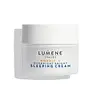What's inside
What's inside
 Key Ingredients
Key Ingredients

 Benefits
Benefits

 Concerns
Concerns

No concerns
 Ingredients Side-by-side
Ingredients Side-by-side

Centella Asiatica Extract
CleansingPanthenol 10%
Skin ConditioningSqualane
EmollientButylene Glycol
HumectantWater
Skin Conditioning1,2-Hexanediol
Skin ConditioningNiacinamide
SmoothingHydrolyzed Jojoba Esters
Skin ConditioningAcrylates/C10-30 Alkyl Acrylate Crosspolymer
Emulsion StabilisingAmmonium Acryloyldimethyltaurate/Vp Copolymer
Hydroxyacetophenone
AntioxidantTromethamine
BufferingDipotassium Glycyrrhizate
HumectantEthylhexylglycerin
Skin ConditioningDisodium EDTA
Xanthan Gum
EmulsifyingSodium Hyaluronate
HumectantMadecassoside
AntioxidantAsiaticoside
AntioxidantAsiatic Acid
Skin ConditioningCopper Tripeptide-1
Skin ConditioningMadecassic Acid
Skin ConditioningCentella Asiatica Extract, Panthenol 10%, Squalane, Butylene Glycol, Water, 1,2-Hexanediol, Niacinamide, Hydrolyzed Jojoba Esters, Acrylates/C10-30 Alkyl Acrylate Crosspolymer, Ammonium Acryloyldimethyltaurate/Vp Copolymer, Hydroxyacetophenone, Tromethamine, Dipotassium Glycyrrhizate, Ethylhexylglycerin, Disodium EDTA, Xanthan Gum, Sodium Hyaluronate, Madecassoside, Asiaticoside, Asiatic Acid, Copper Tripeptide-1, Madecassic Acid
Water
Skin ConditioningPrunus Amygdalus Dulcis Oil
Skin ConditioningHydrogenated Polydecene
EmollientOlus Oil
EmollientGlycerin
HumectantCetearyl Alcohol
EmollientLactococcus Ferment Lysate
Skin ConditioningOctyldodecyl Myristate
EmollientOleyl Erucate
EmollientCetyl Palmitate
EmollientGlyceryl Stearate
EmollientNiacinamide
SmoothingPEG-100 Stearate
Rubus Chamaemorus Seed Oil
Skin ConditioningRubus Chamaemorus Seed Extract
Skin ConditioningPhenoxyethanol
PreservativeHydrogenated Olive Oil
Skin ConditioningCetearyl Glucoside
EmulsifyingPropylheptyl Caprylate
EmollientTocopheryl Acetate
AntioxidantOlea Europaea Fruit Oil
MaskingPropanediol
SolventHippophae Rhamnoides Oil
EmollientAcrylates/C10-30 Alkyl Acrylate Crosspolymer
Emulsion StabilisingEthylhexylglycerin
Skin ConditioningAllantoin
Skin ConditioningOlea Europaea Oil Unsaponifiables
Skin ConditioningLecithin
EmollientTocopherol
AntioxidantPEG-8
HumectantXanthan Gum
EmulsifyingCaprylyl Glycol
EmollientMagnesium Ascorbyl Phosphate
AntioxidantRetinyl Palmitate
Skin ConditioningAlgae Extract
EmollientSodium Hyaluronate
HumectantLactic Acid
BufferingSodium Hydroxide
BufferingSodium Benzoate
MaskingSodium Chloride
MaskingAscorbyl Palmitate
AntioxidantPotassium Sorbate
PreservativeGlucose
HumectantAscorbic Acid
AntioxidantChondrus Crispus
MaskingCitric Acid
BufferingHelianthus Annuus Seed Oil
EmollientRosmarinus Officinalis Leaf Extract
AntimicrobialChondrus Crispus Extract
Skin ConditioningLimonene
PerfumingLinalool
PerfumingCitral
PerfumingParfum
MaskingWater, Prunus Amygdalus Dulcis Oil, Hydrogenated Polydecene, Olus Oil, Glycerin, Cetearyl Alcohol, Lactococcus Ferment Lysate, Octyldodecyl Myristate, Oleyl Erucate, Cetyl Palmitate, Glyceryl Stearate, Niacinamide, PEG-100 Stearate, Rubus Chamaemorus Seed Oil, Rubus Chamaemorus Seed Extract, Phenoxyethanol, Hydrogenated Olive Oil, Cetearyl Glucoside, Propylheptyl Caprylate, Tocopheryl Acetate, Olea Europaea Fruit Oil, Propanediol, Hippophae Rhamnoides Oil, Acrylates/C10-30 Alkyl Acrylate Crosspolymer, Ethylhexylglycerin, Allantoin, Olea Europaea Oil Unsaponifiables, Lecithin, Tocopherol, PEG-8, Xanthan Gum, Caprylyl Glycol, Magnesium Ascorbyl Phosphate, Retinyl Palmitate, Algae Extract, Sodium Hyaluronate, Lactic Acid, Sodium Hydroxide, Sodium Benzoate, Sodium Chloride, Ascorbyl Palmitate, Potassium Sorbate, Glucose, Ascorbic Acid, Chondrus Crispus, Citric Acid, Helianthus Annuus Seed Oil, Rosmarinus Officinalis Leaf Extract, Chondrus Crispus Extract, Limonene, Linalool, Citral, Parfum
 Reviews
Reviews

Ingredients Explained
These ingredients are found in both products.
Ingredients higher up in an ingredient list are typically present in a larger amount.
Acrylates/C10-30 Alkyl Acrylate Crosspolymer is a synthetic polymer. It is used to thicken and improve the texture of products. Due to its properties, it can prevent water and oil ingredients from separating.
Ethylhexylglycerin (we can't pronounce this either) is commonly used as a preservative and skin softener. It is derived from glyceryl.
You might see Ethylhexylglycerin often paired with other preservatives such as phenoxyethanol. Ethylhexylglycerin has been found to increase the effectiveness of these other preservatives.
Niacinamide is a multitasking form of vitamin B3 that strengthens the skin barrier, reduces pores and dark spots, regulates oil, and improves signs of aging.
And the best part? It's gentle and well-tolerated by most skin types, including sensitive and reactive skin.
You might have heard of "niacin flush", or the reddening of skin that causes itchiness. Niacinamide has not been found to cause this.
In very rare cases, some individuals may not be able to tolerate niacinamide at all or experience an allergic reaction to it.
If you are experiencing flaking, irritation, and dryness with this ingredient, be sure to double check all your products as this ingredient can be found in all categories of skincare.
When incorporating niacinamide into your routine, look out for concentration amounts. Typically, 5% niacinamide provides benefits such as fading dark spots. However, if you have sensitive skin, it is better to begin with a smaller concentration.
When you apply niacinamide to your skin, your body converts it into nicotinamide adenine dinucleotide (NAD). NAD is an essential coenzyme that is already found in your cells as "fuel" and powers countless biological processes.
In your skin, NAD helps repair cell damage, produce new healthy cells, support collagen production, strengthen the skin barrier, and fight environmental stressors (like UV and pollution).
Our natural NAD levels start to decline with age, leading to slower skin repair, visible aging, and a weaker skin barrier. By providing your skin niacinamide, you're recharging your skin's NAD levels. This leads to stronger, healthier, and younger looking skin.
Another name for vitamin B3 is nicotinamide. This vitamin is water-soluble and our bodies don't store it. We obtain Vitamin B3 from either food or skincare. Meat, fish, wheat, yeast, and leafy greens contain vitamin B3.
The type of niacinamide used in skincare is synthetically created.
Learn more about NiacinamideSodium Hyaluronate is hyaluronic acid's salt form. It is commonly derived from the sodium salt of hyaluronic acid.
Like hyaluronic acid, it is great at holding water and acts as a humectant. This makes it a great skin hydrating ingredient.
Sodium Hyaluronate is naturally occurring in our bodies and is mostly found in eye fluid and joints.
These are some other common types of Hyaluronic Acid:
Learn more about Sodium HyaluronateWater. It's the most common cosmetic ingredient of all. You'll usually see it at the top of ingredient lists, meaning that it makes up the largest part of the product.
So why is it so popular? Water most often acts as a solvent - this means that it helps dissolve other ingredients into the formulation.
You'll also recognize water as that liquid we all need to stay alive. If you see this, drink a glass of water. Stay hydrated!
Learn more about WaterXanthan gum is used as a stabilizer and thickener within cosmetic products. It helps give products a sticky, thick feeling - preventing them from being too runny.
On the technical side of things, xanthan gum is a polysaccharide - a combination consisting of multiple sugar molecules bonded together.
Xanthan gum is a pretty common and great ingredient. It is a natural, non-toxic, non-irritating ingredient that is also commonly used in food products.
Learn more about Xanthan Gum